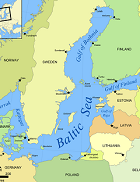The ticking time-bomb at the bottom of the Baltic Sea

There is something dangerous lurking in the shallow waters of the Baltic Sea. Nearly 70 years after the victorious Allies dumped thousands of tonnes of Nazi chemical weapons and chemical agents into the Baltic Sea, experts have warned of an environmental disaster as the weapons corrode and their deadly contents spill into sea.
Under an agreement reached at the Potsdam Conference in 1945, Britain and the Soviet Union dumped around 65,000 tonnes of Germany’s chemical weapons stockpile into the murky depths of the Baltic Sea in 1947-48. Since then the threat posed by the shells and drums full of hazardous waste has been subject to speculation and research. Some scientist called it a “ticking time-bomb”.
It now appears the ticking has got louder. Recent research by Poland’s Military University of Technology has found traces of mustard gas on the sea bed just a few hundred metres off the Polish coast, in the Gulf of Gdansk. This indicates corrosion of the metal, and that poisonous chemicals are now leaking into the water and could be absorbed by fish, entering the food chain. Scientists are concerned, but not just because containers are leaking. There should be no chemical weapons in the Gulf of Gdansk as this was not a dumping zone. Stanislaw Popiel, from the team of the military university, which carried out the research, said that it was hard to say where the contamination came from.
 One possible explanation is that the Soviets had a fairly care-free attitude to where they dumped the weapons. Although the vast majority of the munitions were thrown into the Bornholm and Gotland deeps, Jacek Beldowski, from the Polish Institute of Oceanography, said the Soviets often threw everything overboard “as soon as they were out of sight of land”. This means there could be tonnes of chemical weapons lying in unknown locations, close to land and in fishing zones. Mr Beldowski has also found an increase in fish with illnesses and genetic defects in the areas of the known dumping zones; evidence that some of the containers are indeed leaking.
One possible explanation is that the Soviets had a fairly care-free attitude to where they dumped the weapons. Although the vast majority of the munitions were thrown into the Bornholm and Gotland deeps, Jacek Beldowski, from the Polish Institute of Oceanography, said the Soviets often threw everything overboard “as soon as they were out of sight of land”. This means there could be tonnes of chemical weapons lying in unknown locations, close to land and in fishing zones. Mr Beldowski has also found an increase in fish with illnesses and genetic defects in the areas of the known dumping zones; evidence that some of the containers are indeed leaking.
While this is worrying, some scientists argue that most of the containers will in all likelihood remain sealed for decades to come, and that the environmental conditions at the bottom of the Baltic Sea should contain any hazards. The cold temperatures turn mustard gas into a thick solid state, making it difficult for any contamination to spread. But the fact that contamination is spreading and affecting the environment, and that nobody really knows where all the chemical weapons are, is a serious cause for concern. In Mr Popiel’s worst-case scenario the Baltic area could be hit by an “environmental disaster greater than Chernobyl” within a few years.
These dangers have spurred the Baltic states into examining the possibility of removing some of the weapons from the sea bed. Poland’s Environmental Protection Agency has suggested enlisting the help of NATO because it has the funds and the technology needed to lift the toxic waste. But even if the alliance agreed to help, any salvage operation would be fraught with danger. Experts warn that attempts to raise the fragile rusting shells and drums could actually break them up and trigger a massive release of deadly chemicals.
*Original story: The Economist via Google News

Post your comment
You cannot post comments until you have logged in.
Login to post a commentComments
No one has commented on this page yet.
RSS feed for comments on this page | RSS feed for all comments